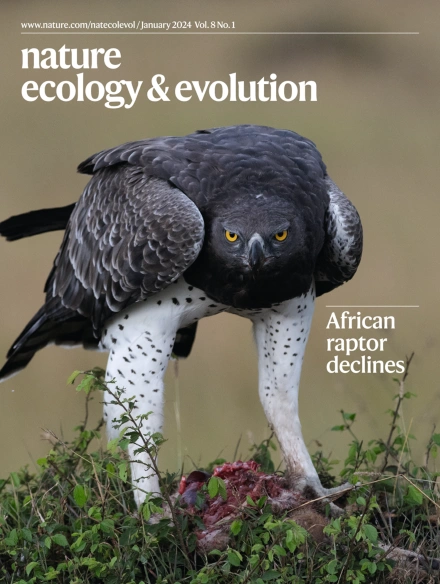高山植物伪装的遗传基础及其与食草昆虫的长期共同进化
IF 13.9
1区 生物学
Q1 ECOLOGY
引用次数: 0
摘要
通过颜色变化来伪装可以包括可逆的或永久的变化,以应对周期性捕食者或食草动物的压力。伪装表型背景匹配的进化部分取决于伪装性状的遗传,但这在植物中很少受到关注。本文阐明了青藏高原灰叶烟叶草(Corydalis hemidicentra)的遗传途径,这种植物通过伪装逃避寄主专化的Parnassius蝴蝶毛虫的食草性。田间试验结果表明,与周围草甸生境相匹配的伪装灰叶减少了雌蝶的产卵和毛虫的食草性,结果坐果率高于绿叶植物。防守完全是视觉上的。多组学数据和功能验证表明,插入254 bp的转座子导致花青素在叶片中积累,使其呈现岩石般的灰色。对过去500年植物和蝴蝶有效种群大小的统计分析表明,在有伪装的地点,植物种群比只有绿叶植物的地点更稳定。在最近的过去,在有伪装植物的地方,Parnassius蝴蝶的数量有所下降。这些发现为植物伪装特性的遗传学及其在植物-食草动物相互作用的快速变化动力学中的潜在作用提供了见解。本文章由计算机程序翻译,如有差异,请以英文原文为准。


Genetic basis of camouflage in an alpine plant and its long-term co-evolution with an insect herbivore
Camouflage through colour change can involve reversible or permanent changes in response to cyclic predator or herbivore pressures. The evolution of background matching in camouflaged phenotypes partly depends on the genetics of the camouflage trait, but this has received little attention in plants. Here we clarify the genetic pathway underlying the grey-leaved morph of fumewort, Corydalis hemidicentra, of the Qinghai-Tibet Plateau that by being camouflaged escapes herbivory from caterpillars of host-specialized Parnassius butterflies. Field experiments show that camouflaged grey leaves matching the surrounding scree habitat experience reduced oviposition by female butterflies and herbivory by caterpillars, resulting in higher fruit set than that achieved by green-leaved plants. The defence is entirely visual. Multi-omics data and functional validation reveal that a 254-bp-inserted transposon causes anthocyanin accumulation in leaves, giving them a rock-like grey colour. Demographic analyses of plant and butterfly effective population sizes over the past 500 years indicate that plant populations have been more stable at sites with camouflage than at sites with only green-leaved plants. In the recent past, populations of Parnassius butterflies have declined at sites with camouflaged plants. These findings provide insights into the genetics of a plant camouflage trait and its potential role in the rapidly changing dynamics of plant–herbivore interactions. Multi-omics analysis reveals that a 254-bp transposon induces defensive camouflage in an alpine plant and reduces herbivory by caterpillars of a specialist butterfly. Protective effects of this camouflage are reflected in the long-term dynamics of co-evolving plant and butterfly populations.
求助全文
通过发布文献求助,成功后即可免费获取论文全文。
去求助
来源期刊

Nature ecology & evolution
Agricultural and Biological Sciences-Ecology, Evolution, Behavior and Systematics
CiteScore
22.20
自引率
2.40%
发文量
282
期刊介绍:
Nature Ecology & Evolution is interested in the full spectrum of ecological and evolutionary biology, encompassing approaches at the molecular, organismal, population, community and ecosystem levels, as well as relevant parts of the social sciences. Nature Ecology & Evolution provides a place where all researchers and policymakers interested in all aspects of life's diversity can come together to learn about the most accomplished and significant advances in the field and to discuss topical issues. An online-only monthly journal, our broad scope ensures that the research published reaches the widest possible audience of scientists.
 求助内容:
求助内容: 应助结果提醒方式:
应助结果提醒方式:


